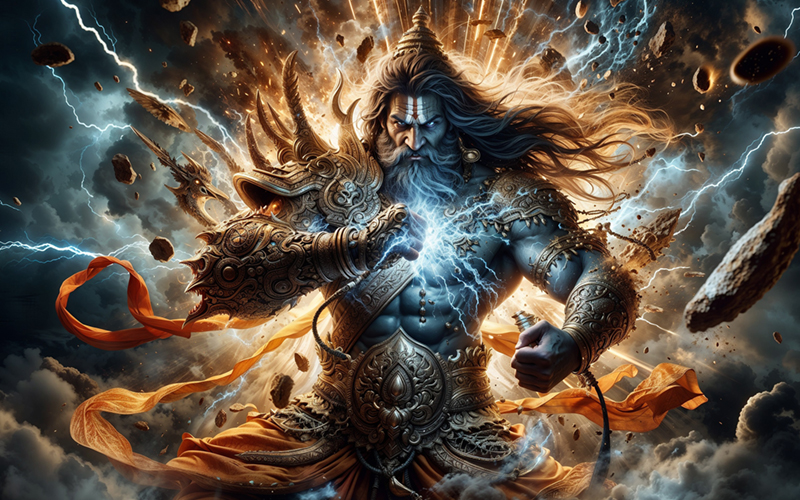Physical Address
Empirical System, 105 First Floor Pitru Krupa, Opp. R.K. Desai College, Koparli Road, Vapi (Gujarat) 396 191
Physical Address
Empirical System, 105 First Floor Pitru Krupa, Opp. R.K. Desai College, Koparli Road, Vapi (Gujarat) 396 191

The Saga of Sahasrakavacha: Karna’s Previous Life
The Rise of Dambhodbhava
Long before the events of the Mahabharata, there lived a powerful and ambitious asura named Dambhodbhava. Driven by a desire for power and invincibility, Dambhodbhava embarked on a rigorous penance to Lord Surya, the Sun God, seeking a boon that would make him unbeatable. Pleased with his intense devotion, Surya granted Dambhodbhava a remarkable boon: a thousand armors, each of which could only be shattered by a warrior who had performed a thousand years of penance. With this boon, Dambhodbhava became Sahasrakavacha, meaning “one with a thousand armors,” a title that soon struck fear across the three worlds.
Empowered by his new invincibility, Sahasrakavacha began a campaign of terror, waging war against the gods and creating chaos in the universe. His power was so great that even the mightiest deities were unable to defeat him. The gods, sages, and celestial beings lived in constant fear of his wrath, unable to find a way to stop his tyranny.
The Arrival of Nara and Narayana
Desperate for a solution, the gods turned to Lord Vishnu, the preserver of the universe. Understanding the gravity of the situation, Vishnu decided to incarnate as the twin sages Nara and Narayana, who were known for their unparalleled devotion and strength. The mission of these sages was clear: to end the terror of Sahasrakavacha.
Nara and Narayana were born as ascetic brothers, dedicating their lives to meditation and the worship of the divine. When they learned of Sahasrakavacha’s tyranny, they vowed to put an end to his reign. However, they knew that defeating him would require immense patience and divine assistance.
The Cycle of Penance and Battle
Nara and Narayana devised a strategy to defeat Sahasrakavacha. Nara would begin by performing a thousand years of intense penance to Lord Shiva. During this time, Narayana would stand guard, ensuring that Sahasrakavacha did not disturb the penance. After the thousand years were completed, Nara would challenge Sahasrakavacha in battle.
When Nara completed his thousand years of penance, he emerged with divine power and confronted Sahasrakavacha. In a fierce battle, Nara succeeded in breaking one of Sahasrakavacha’s armors. Though this was a significant victory, Sahasrakavacha still had hundreds of armors left, each one as impenetrable as the last.
After the battle, Narayana began his own thousand-year penance to Lord Shiva while Nara protected him. Once the penance was complete, Narayana engaged Sahasrakavacha in battle, breaking another of his armors. This cycle continued for thousands of years, with Nara and Narayana alternately performing penance and battling Sahasrakavacha, gradually reducing his power.
The Final Battle and the Curse of Rebirth
Eventually, after thousands of years, the last of Sahasrakavacha’s armors was shattered. With no protection left, Sahasrakavacha was finally defeated by the combined might of Nara and Narayana. His body, once invincible, lay broken and lifeless, and his reign of terror was at an end.
However, Sahasrakavacha’s story did not end there. According to some interpretations of the Brahmanda Purana and Matsya Purana, Sahasrakavacha was cursed to be reborn as a mortal due to the havoc he had wreaked. This curse led to his rebirth as Karna, the son of Kunti and Surya, in the Dwapara Yuga.
Rebirth as Karna
In his new life as Karna, the shadow of Sahasrakavacha’s past hung over him. Born with natural armor and earrings granted by Surya, Karna was a man of immense power and valor. However, his life was marked by struggle, rejection, and tragedy, much like his previous life.
Despite his greatness, Karna was often shunned due to the mysterious circumstances of his birth and his loyalty to Duryodhana, the prince of the Kauravas. He longed for recognition and respect but faced constant obstacles. The karmic cycle that began with Dambhodbhava’s arrogance and ambition seemed to continue in Karna’s life.
During the great battle of Kurukshetra, Karna faced Arjuna, who was the reincarnation of Nara, in a confrontation that was destined by fate. When Indra, the king of the gods, took away Karna’s natural armor and earrings, it was as if the last remnants of Sahasrakavacha’s protection were stripped away. In the end, Arjuna fulfilled the ancient karma by killing Karna, thus ending the cycle that began with Sahasrakavacha.
Conclusion: The Debate and Legacy
It is important to note that while some traditions and interpretations link Sahasrakavacha to Karna, this connection is not universally accepted. In many versions of the Mahabharata and other texts, Karna’s divine armor and earrings are simply attributed to his birth as the son of Surya, with no mention of a past life as Sahasrakavacha. Some scholars argue that the identification of Karna with Sahasrakavacha might have been a later addition or interpretation rather than an original part of the scripture.
Nevertheless, the story of Sahasrakavacha and Karna serves as a powerful illustration of the cyclical nature of karma and the profound ways in which past actions influence future lives. It highlights the inevitability of divine justice and the complexity of destiny.